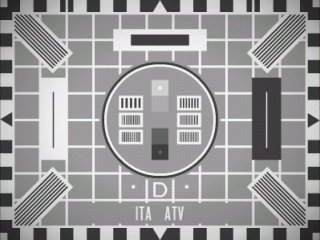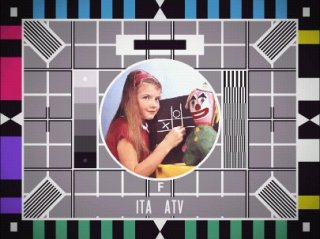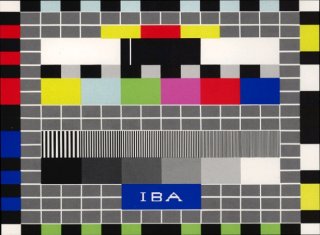This page last updated on Friday, October 13, 2006 at 9:45:57 AM
| Home | | ATV | | ATV Centre | | Schools | | Fenton Relay | | Antenna Theory | | Other Pages |
ATV Test Cards
Before programmes began, TV companies broadcast "Trade Test Transmissions," which enabled people working in the television trade (e.g. TV set installers), and indeed the public, to test and set-up their recieving equipment. The test card would usually be accompanied with tone (a single, continuous note) or music.
Thanks to Dave Jeffery for his re-creations of the ATV Test Cards.
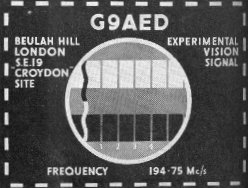 |
This was a Tuning Signal radiated in the London area before ITV began in September, 1955. The squiggly line was used as a guide to reveal the distance between the receiver and a landscape feature causing ghosting. Note the call-sign of the station, G9AED, at the top. The station radiating this caption was most likely a mobile transmitter for test purposes. 194.75 Mc/s (megacycles per second) or 194.75MHz in modern terminology, is Band III Channel 9. No sound was broadcast with this caption, as it says "Experimental vision signal," and there is no sound frequency.
Thanks to Lee Jones for the scan. |
|
This later design was for testing the Lichfield transmitter, radiated before any ITV programmes were transmitted in the Midlands area. These tuning signals were used for comparing the predicted coverage area (i.e. on paper) with the actual coverage area, and to do any tweaking if necessary. Note that the call-sign is the same as for the Croydon Tuning Signal above - I guess that the same mobile transmitter was used for testing both at Croydon and Lichfield, hence the same call-sign. 189.75MHz is Band III, Channel 8. The sound is slightly below the vision at 186.25MHz, and would probably been tone. To find out more about the different bands that have been / are used for broadcasting in the UK, try the Physics of Antenna Design. The mast currently at Lichfield is not the original one (a tower), which was replaced in 1961, by a mast. Mike Brown's Transmitter Gallery has some pictures of the current mast. |
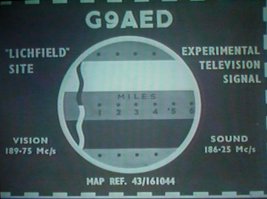
|
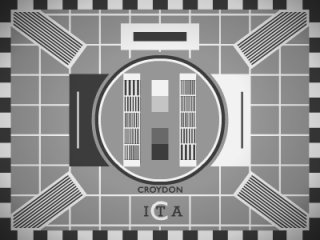 |
It is not clear exactly which test cards were used at the very beginning of ITV; proprietary test cards were used along with the "industry standard" card of the time, Test Card 'C'. Tuning Signal 2, as used on start-ups, was a simplified version of 'C'. There was also a version for the Lichfield transmitter. If you want to see some of ITV's proprietary, in-house test cards try Darren Meldrum's Test Card Gallery. Re-creation by Dave Jeffery |
|
In the early days, test cards sometimes gave other information, as in this example, informing viewers that the transmitter was running on reduced power. If the viewer lived on the fringes of reception and the transmitter was on reduced power, the signal received would be noisy, in the form of speckles, often referred to as 'snow', on the screen. Informing viewers that the station was on reduced power would reassure them that nothing was wrong with their set or aerial and that they wouldn't need to make any adjustments to their set-up. If an ITV area had more than one transmitter, the card would be transmitted from the transmitter site, the card being generated by a slide-scanner. In the early years, transmitters used to be manned, but later a single control room, called a Regional Operations Centre (ROC), could monitor many transmitters' (that could operate unattended) output at once, eliminating the need for transmitters to be manned. Re-creation by Dave Jeffery |
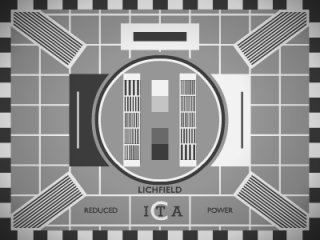 |
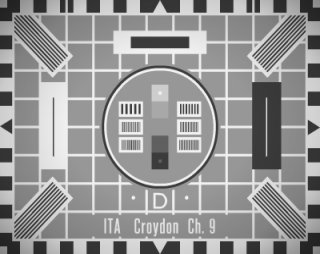 |
Test Card 'D' was adopted by both the BBC and ITA. D was introduced on the BBC in 1964, and presumably around the same time on the ITA. Dave says: "The card would be shown with test-card music, then ten minutes of black in silence, then the start-up [with Picasso] would begin." You can find out more about test-cards at Darren Meldrum's MHP. Re-creation by Dave Jeffery |
|
Over the years engineers had been developing a pattern that actually rigorously tested the reciever rather than simply displaying Tuning Signals (used by the set owner to properly set up the television before programmes began). Test Card 'D' was the first Test Card to be produced to a technical specification. You can see some of the ideas that were carried forward for use in Test Card 'F', below. 'D' was transmitted, with transmitter name and channel number, on ITV until February 1965. Re-creation by Dave Jeffery |
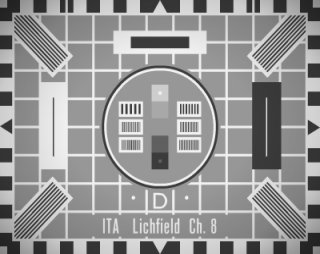 |
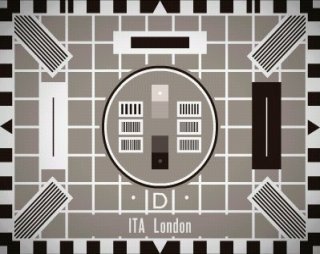 |
This variant on 'D' has the transmitter name and channel number changed for the region name. Re-creation by Dave Jeffery |
|
This is the Midlands variant. This type (using region names) were used from February 1965 until 1968. Re-creation by Dave Jeffery |
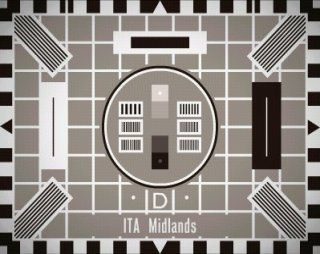 |
|
|
The final 'D' to be used was this type, with the name of the ITV contractor replacing the region name. It was used from 1968 until the introduction of colour. The colour test card, 'F', was transmitted on the VHF 405-line network, but whether it was from 15th November 1969 (the date of the introduction of colour) or not is unclear. Tez Burke: "TCF was certainly broadcast by the ITA over the 405-line network, [..] from Lichfield on [channel] 8 and Emley Moor on [channel] 10." |
|
With the introduction of colour in November 1969, the ITA decided to use the industry-standard Test Card 'F'. Here's the first version of that, still using the same typeface for "ITA ATV Network" as had been used since the introduction of Test Card 'D' in the mid-60s. It is the opinion of correspondents that this card was captioned "ITA ATV" as shown. Can you confirm or disprove? Please let me know!
Andrew Richardson remembers: "Test Card F as I remember (from school holiday time) would appear at 9.35. Prior to this,colour bars and tone was shown. The test card with Beethoven's Symphony No.3 then appeared until 10.00[, with] colour bars and tone for 5 mins. Then the test card reappeared at 10.05 then playing Tchaikovsky's Piano Concerto No.1. The test card then faded; colour bars and tone (I think) was shown for 10 mins prior to sign-on of ATV at approx. 10.45-11.00." Re-creation by Dave Jeffery. |
|
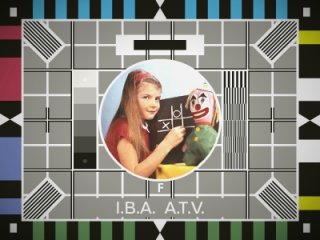
|
At some point, after 1972, the legend at the bottom of Test Card 'F' changed to this typeface. There would be a tone with this - no music. It's thought that this card appeared about 8.10-ish, and colour bars (with the bottom half of the screen red) replaced it about 10 minutes before programmes started. There would then be a length of time where the screen was black (possibly a minute or so) before the start-up began. Can you add to this? Re-creation by Dave Jeffery. |
|
Electronic Test Pattern 1, or ETP-1, was introduced in 1980/81 with the introduction of Regional Operations Centres (ROCs). ROCs replaced the staff at each main transmitter, converting the transmitters to remote control operation. ETP-1 remained in service until ITV commenced 24 hour broadcasting. We have a copy of the IBA's leaflet on ETP-1 on-site, where there is a nice, big picture of it. Test Card 'G' was apparently used as well by the ITA/IBA - can anyone add dates to this? How was it captioned? Please let me know! The latest is that it was used in the early eighties (not necessarily exclusively, though) and was uncaptioned. |

